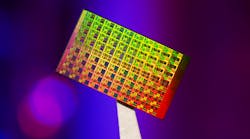One of the fundamental properties of antennas is reciprocity, or their ability to transmit and receive radio signals with the same efficiency. That natural symmetry is not always an advantage, since it makes antennas more susceptible to noise and interference as they get better at handling radio waves.
Now, researchers from the University of Texas at Austin have developed an antenna not bound by the same property. This “non-reciprocal” antenna can independently control signals entering and exiting the antenna more efficiently, and without the need for other electrical components to keep out noise.
Normally, antennas transmit and receive signals over the same path, so that when it "opens" to let signals out, rogue signals that reflect off objects or walls can leak back through the channel. That impacts the quality of the transmission—introducing static into a phone call, for instance. To combat these effects, special isolators are used to prevent noise from leaking into antenna amplifiers.
The new design, however, limits the effect of those rogue signals. “We break the symmetry between transmission and reception signals, so we are able to prevent the antenna from having to listen to reflections and echoes that affect the source,” said Andrea Alu, an associate professor of electrical engineering at UT Austin, in a statement.
The findings, which were published in the journal Proceedings of the National Academy of Sciences, could enable faster data rates and clearer telecommunications. Keeping noise and echoes out of the antenna could also help reduce the number of non-reciprocal devices like isolators and circulators used in antennas, reducing their size and cost.
The team’s experiments involved feeding an antenna a low-frequency modulation signal while it was transmitting or receiving an RF signal. That low-frequency signal, which was temporally modulated, slowly changed the properties of the antenna, interrupting its natural symmetry.
The signal altered how efficiently the antenna receives transmissions and how efficiently it sends them. In the experiments, the researchers were able to make antenna hundreds of times less sensitive to incoming radio waves when it was sending out information.
With the experiments done, the researchers are now mulling new applications for the technology. It might be applied to thermophotovolatic cells, devices that convert heat from the sun into electricity. Like antennas, these devices are forced to emit light as efficiently as they absorb it, limiting their overall efficiency. The new antenna technology could help these devices more efficiently absorb light while reflecting less of it away.
